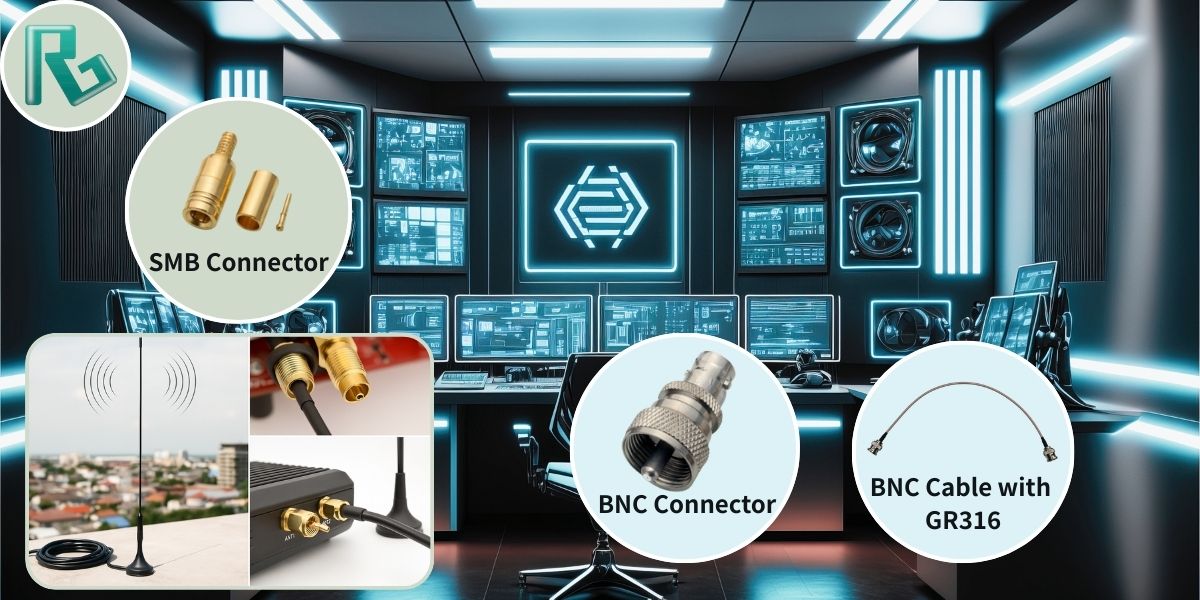In high-frequency and high-speed transmission systems, the choice of connector can make or break signal quality. Among the most common options, SMB vs BNC connectors often raise questions for engineers and buyers alike. While both are coaxial designs, their size, connection mechanism, and frequency performance differ significantly, making each suitable for specific applications. From BNC connector 12G-SDI video in broadcasting to SMB connector wireless networks in compact telecom devices, understanding these differences is key. This article offers a practical selection guide to help you choose the right connector for your project.
Background
In the world of radio frequency (RF) and high-speed transmission, connectors are critical for signal quality and system reliability. Among the most widely compared types are SMB vs BNC connectors. Both are coaxial connectors with decades of use in industries such as telecommunications, broadcasting, test instrumentation, and wireless systems. While they may look similar at first glance, their differences in design, frequency range, and durability make them suited to very different roles. For engineers and purchasing specialists, knowing when to choose an SMB plug over a BNC connector is essential to achieving the right balance of size, performance, and cost.
Common Challenges
Compatibility of 50Ω and 75Ω Variants
Both SMB and BNC connectors are offered in 50Ω and 75Ω versions. A frequent issue occurs when a 50Ω plug is accidentally inserted into a 75Ω jack, risking mechanical deformation and signal reflection. This mismatch can significantly degrade performance, especially in precision video and RF systems like BNC connector 12G-SDI video transmission, where impedance control is non-negotiable.
Balancing Size and Durability
BNC connectors use a bayonet-style twist-and-lock mechanism that ensures mechanical security and resistance to vibration. In contrast, the SMB plug employs a snap-on interface, enabling rapid connection and disconnection in tight spaces. However, this design is less robust in high-vibration environments, creating challenges for field applications.
Frequency Range Limitations
Both SMB and BNC are generally rated up to about 4 GHz, though certain SMB designs can extend toward 10 GHz. When engineers underestimate these limits, system performance may suffer from insertion loss or return loss. In such cases, higher-performance connectors like SMA may be more appropriate.
Solutions
Choosing the Right Connector for the Right Application
-
Video and Broadcasting: For uncompressed 4K and professional broadcast setups, BNC connector 12G-SDI video solutions are industry standard. Variants like HD-BNC and Micro-BNC further support high-density racks.
-
Wireless and Telecom Systems: SMB connector wireless networks are widely used in telecommunications, GPS receivers, and compact RF devices. Combined with precision SMB cable assemblies, they deliver high-density packaging without compromising performance.
-
Test and Measurement: SMB connectors, especially mini-75Ω versions, are ideal for PXI modular test systems where space is limited. BNC connectors, on the other hand, dominate oscilloscopes and RF test benches because of their secure locking feature.
Considering Durability and Maintenance
For applications requiring frequent mating cycles or strong vibration resistance, the bayonet lock of BNC ensures stable connections. In contrast, for high-density electronic assemblies, the smb plug provides quick handling and efficient integration.
Manufacturing and Quality Factors
Connector reliability is closely tied to machining precision and surface treatment. CNC machining guarantees tolerance control, concentricity, and finish, which are crucial for RF performance. Plating options such as gold, silver, and nickel reduce contact resistance and extend lifespan. By applying these processes, manufacturers like RunGu produce SMB cables and BNC assemblies that meet MIL-STD-348 and MIL-C-39012 standards.
Case Studies
Case 1: Broadcast Video Transmission (12G-SDI)
A broadcasting company needed reliable 12G-SDI transport for live 4K events. By adopting 75Ω BNC connectors, they achieved stable performance across cameras, switchers, and routing systems, while minimizing return loss.
Case 2: Wireless Communication Devices
A telecom equipment provider faced strict space constraints in compact base-station modules. They adopted SMB connectors with custom SMB cable assemblies, which allowed efficient integration into wireless modules without sacrificing signal performance.
Case 3: Test and Measurement Systems
An instrumentation manufacturer deployed smb plugs inside PXI modules for their space-saving snap-on interface, while retaining BNC ports on oscilloscopes for durability in daily laboratory use. This hybrid approach balanced density and robustness.
Selection Guide: Making the Right Choice
When choosing between SMB and BNC connectors, consider these critical factors:
Choose SMB connectors when:
- Space constraints require miniaturization
- High-density packaging is essential
- Frequent connection/disconnection is needed
- Wireless communication applications demand compact design
- Assembly speed is a priority
Choose BNC connectors when:
- Mechanical reliability is paramount
- Video signal integrity is critical
- Vibration resistance is required
- Test equipment applications need secure connections
- Long-term connection stability is essential
The decision ultimately depends on balancing performance requirements, environmental conditions, and application-specific constraints. Both SMB and BNC connectors continue to serve vital roles in modern RF and high-speed transmission systems, each optimized for their respective applications and use cases.
Frequently Asked Questions (FAQ)
Q1: Can I interchange 50Ω and 75Ω connectors?
No. Mixing them can cause connector damage and degrade RF performance. Always match impedance.
Q2: What is the frequency range of SMB vs BNC connectors?
Both typically support up to 4 GHz. Certain SMB models can reach 10 GHz, but performance declines beyond rated limits.
Q3: Which connector should I use for 12G-SDI video?
The 75Ω BNC connector is the standard for professional 12G-SDI video systems, including HD-BNC and Micro-BNC versions.
Q4: Where are SMB connectors commonly used?
They are widely used in wireless networks, GPS receivers, and compact RF electronics, where size and quick assembly are priorities.
Explore Our SMB and BNC Connector Solutions
Looking for high-precision RF components? RunGu offers a full range of SMB connectors and BNC connectors, designed and manufactured with CNC accuracy to ensure reliability in broadcasting, telecommunications, and test equipment applications. Discover how our custom machining solutions can meet your project needs.
Author: CNC Machining & Manufacturing Specialist|RunGu Enterprise Expert Team
Focused on CNC automatic lathes and mill-turn machining with nearly 30 years of hands-on experience.
About RunGu Enterprise Co., Ltd.
RunGu Enterprise Co., Ltd., based in New Taipei City, Taiwan, is a precision CNC machining manufacturer with nearly 30 years of experience. We provide one-stop customized solutions, including standoffs, RF coaxial connectors, pogo pins, shielding boxes, liquid cooling couplers, and other CNC metal components. Our products are widely used in electronics, telecommunications, medical devices, automotive, and industrial automation industries.
🌐 Learn more: www.standoffs-tw.com





